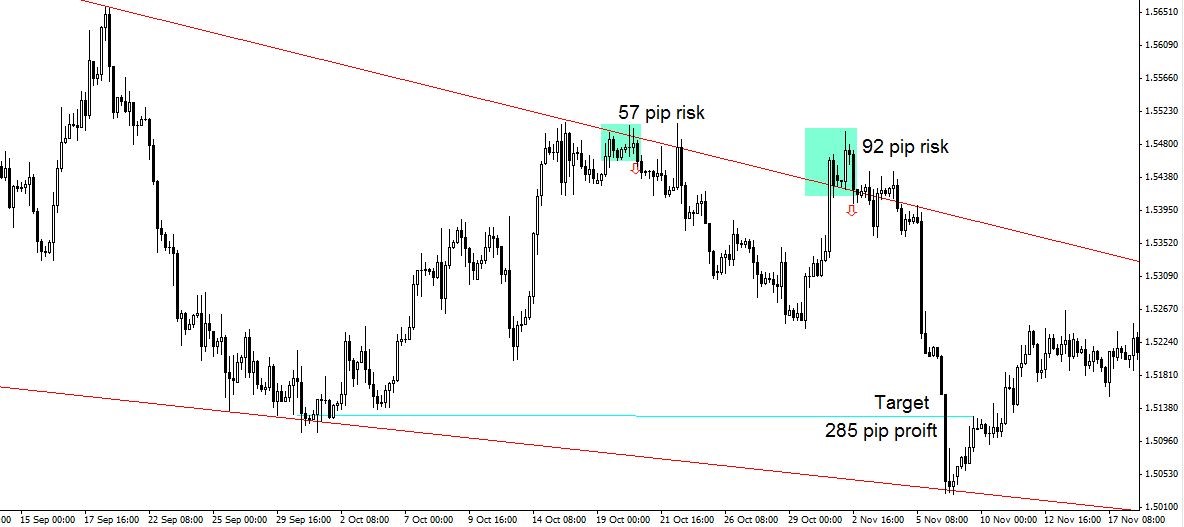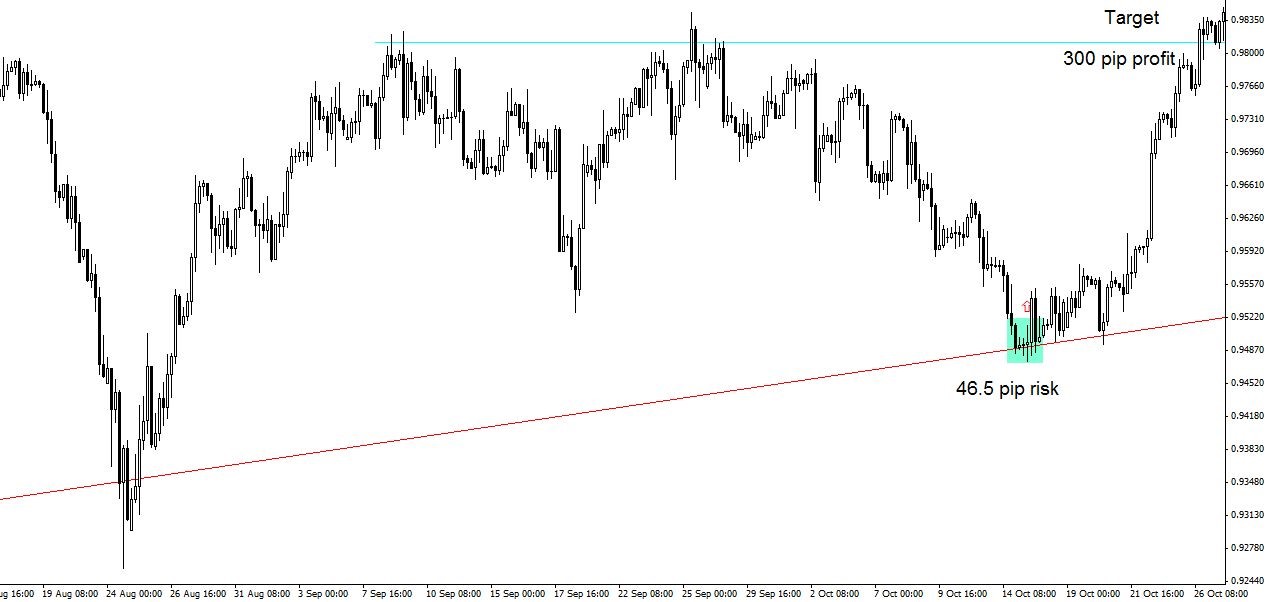By: Cory Mitchell, founder of VantagePointTrading.com
Whether I'm day trading or swing trading forex (and other markets as well), I frequently use the method described below. It's a price action trading method, with trendlines and trend channels used to help establish entry points and potential targets. Here's the basic strategy; adjust it to your liking or add your own indicators to help you implement it.
Before Placing Trades
Before placing a trade, calculate your proper position size. Position size is calibrated for the trade so you are risking 1% (or less) of your account capital on each trade. All trades taken must have at least a 2:1 reward:risk ratio, but often we'll end up with trades that have a 5:1 or 6:1 ratio (more on that in a bit). If risking 1% of your account, you stand to make at least 2%, but often 5% or more...that's 5% on your total account, not just traded capital (because our risk is also based on the total account). If you risk up to 2% per trade, your gains double.
Before commencing trade, note any significant economic data coming out over the next 24-hours. Avoid placing entries or stop loss orders close the current price right before a major news announcement, as this can cause slippage. Best to avoid those trades.
Trend-Pullback-Consolidation
The strategy involves three checkpoints. There needs to be a trend (or a defined pattern, such as a range or triangle chart formation), then a pullback against the trend, and then a consolidation. All three things need to be present in order to take a trade.
Spotting a trend or range is the easiest part. These patterns give us the directional bias we want to trade in; if the trend is up only consider long (buy) trades, if the trend is down only consider short (sell) trades. If the price is moving in a big range, we want to buy near the bottom and short near the top.
The pullback is the part that takes practice. How far does the price need to pullback? The answer is: it varies. Trendlines can provide a guide for how far the price should pullback before considering a trade. Other indicators such as Bollinger bands, a moving average or envelopes can also be calibrated to provide a more dynamic trendline.
Once a trend (or other pattern) is isolated, we wait for a pullback to our trendline (or indicator) area. The next step is waiting for a consolidation. A consolidation is 4-bars that move mostly sideways. Mark the high and low of the consolidation as they will establish our entry and stop loss points. If the trend is up, buy on a breakout above the consolidation--the bid price must move 1 pip above the consolidation high in order to trigger a long trade (remember to factor for the spread when placing buy orders). If the trend is down, short on a breakout below the consolidation--the bid price must move 1 pip below the consolidation low in order to trigger a short trade.
The trendlines and/or indicators are just guides; the price doesn't need to stop right at them. For example, if the price moves a bit past the trendline and then consolidates, that's fine.
When buying, a stop loss goes 5 pips below the consolidation low. When shorting the consolidation goes 5 pips, plus the average spread, above the consolidation high. This applies to major forex pairs; for other pairs adjust the stop loss to match volatility.
Set a target based on the typical price wave distance of a trend, but be conservative. For example, if buying a forex pair that's in an upward trend channel (you'll examples of trend channel in the charts below), instead of putting the target right at the top of the trend channel (which the price has shown a tendency to reach), place it near a prior peak in price. This conservative approach still reaps a nice profit but gets you out of the trade even if the price forms a double top (fails to trend above the prior high). The same concepts apply to downtrends.
Once you know your entry, stop loss and target price, only take trades that offer a 2:1 reward:risk ratio or greater. Favor trades with higher reward:risk ratios.
If you're starting out, trading trend channels is a great place to start because channels give you some guidance on your target areas. If trend isn't moving within a well defined trend channel, still use the same approach--in a downtrend place your target near the prior swing low. In an uptrend, place your target near the former high. As you improve, fine tune targets for each trade based on the tendencies of the pair you're trading.
Here are a few examples. In the case of a downtrend, the bottom of the drawn box marks the short entry point and the top of the box marks the stop loss. In an uptrend, the top of the box marks the long entry point and bottom of the box marks the stop loss.
Figure 1. GBPUSD 4-Hour Chart

Figure 1 shows two entry points which eventually reached the target. The first entry point had about a 5:1 reward:risk, the second entry point had about a 3:1 reward:risk.
Figure 2. USDCHF 4-Hour Chart

This pair continued to trend after the price reached the target. That's fine. Get back in on the trend when a valid pullback and consolidation occur again. This trade offered a more than 6:1 reward:risk, and was based on nothing more than tendencies we had seen over the last several months.
Note: I don't draw trendlines precisely. I just throw them on my chart; they are only a guide anyway so they don't need to connect exact highs/lows.
Final Word
This is a great strategy...although it takes practice to get the hang of. If you start throwing money at every consolidation that occurs near a trendline, you'll lose a lot of cash quickly. Isolate, and draw your trendlines on, strong well structured trends on the daily or 4-hour chart (your dominant time frame). This time frame is also useful for picking a target area. Then drop to the lower time frame to see your consolidation and establish your exact entry, stop loss and target. It's recommend you practice this strategy for a couple months in a demo account and gain consistency before using it with real capital.
Cory Mitchell is a Chartered Market Technician (CMT), founder of VantagePointTrading.com and the author of the Forex Strategies Guide for Day and Swing Traders.
